Cool Jobs: Counting calories
Meet three researchers working to understand the secrets of food
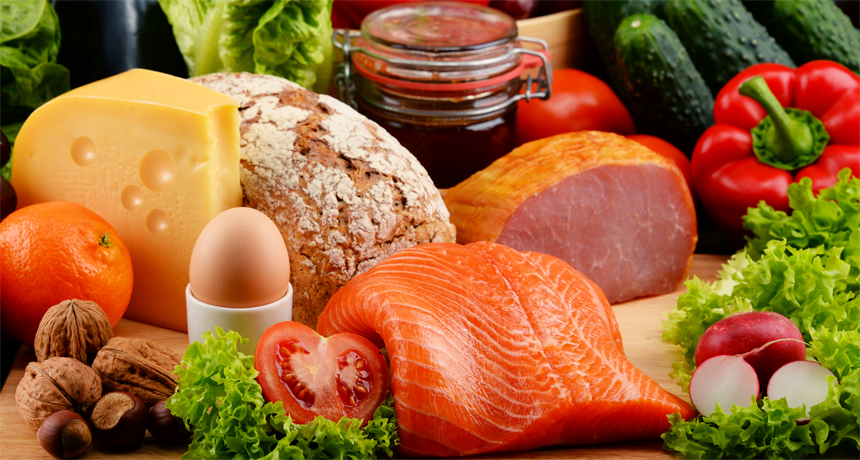
How much energy does your body get out of foods? Researchers are finding that the answers can be challenging, depending on the food type and how it has been prepared.
Daisy-Daisy/iStockphoto
David Baer glances at a delicious breakfast: fried eggs and toast. Then he tips it all into a blender. WHIRRRR. He’s not about to eat this odd smoothie. Rather, blending is one step in the process of determining how many calories the meal contains. Once mixed, he’ll set the material on fire. Later, he’ll blend and burn feces and urine from a volunteer who ate the same — but unblended — breakfast.
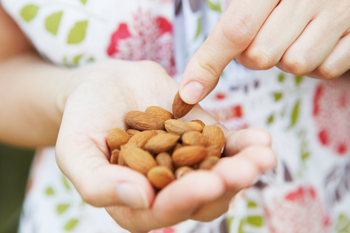
It’s all in a day’s work for Baer and his research team at the Beltsville Human Nutrition Research Center in Maryland. It’s part of the nation’s Agricultural Research Service. This ARS team studies food and its relationship to health. One important focus of its research is the calorie. This unit of measurement reveals how much energy food provides the body.
To get energy out of food, the body breaks it up and then burns the molecules. Yes, your body works like a furnace! So stoke it with fuel — food — and it will keep you warm and provide the energy you need to grow, move, think and perform other tasks.
A calorie is a measure of the amount of heat produced by this process. The term “calorie” on food labels is actually short for kilocalorie. That’s how much energy it takes to raise the temperature of one kilogram (2.2 pounds) of water by 1 degree Celsius (1.8 degrees Fahrenheit).
Calorie estimates show up on restaurant menus and food labels. Some dieters obsessively count them. They hope to consume fewer calories than they will use to do work — and thereby lose weight. But human nutrition is complex. And calorie counts on food labels don’t tell the whole story.
Here, we meet two nutritionists and a food scientist who are looking at the calorie in new ways. All three are trying to better understand food to help people stay healthy. Baer is learning that some foods provide the body with fewer calories than expected. Another nutritionist wants to train the brain to prefer lower-calorie foods. And a food scientist uses chemistry to design new products and cooking methods to help reduce the availability of a food’s calories.
From antelopes to almonds
What do antelopes, iguanas and people have in common? Baer has studied how all of them eat. He started out as a zoologist studying the diets of wild animals. Later, he switched his focus to people. Human or beast, though, he notes that he’s always been interested in “how we eat food, digest food, process it in our bodies, turn it into muscle or fat and burn it for energy.”

Lately, his team has been going nuts. They’ve been studying the calories in pistachios, almonds and walnuts. One common nutrition rule states that each gram of fat that is eaten, no matter what type or where it comes from, provides the body with 9 calories of energy. This is the rule that most food companies use to create food labels. Baer’s team wanted to test that, using nuts.
Baer’s team used the same experiment for each nut. It recruited 18 healthy adult volunteers to eat all of their meals at the Beltsville research center for two three-week periods. (Those two periods did not necessarily run back-to-back.) During the first, the volunteers ate typical American meals. For example, breakfast might be eggs and toast. During the second week of each series, the researchers reduced the number of calories in the original meal. Then they substituted almonds or another nut to make up the difference in calories.
The volunteers’ bodies adjusted to the new diet during the first nine days of each study period. During the next nine days, the blending fun began.
The researchers mixed and blended food that was identical in type and amount to what each volunteer had eaten that day. Then they freeze-dried the mix and crushed it into a fine powder. Each day’s powder was then combined into a final mix. Baer’s team took a gram of it and put it into a device known as a bomb calorimeter (Kal-oh-RIM-eh-tur). Scientists use this device to measure the heat released in a chemical reaction — in this case, the burning of the powdered food.
Baer or a colleague fills the device with pure oxygen, then seals it inside a tank of water. When the researcher turns on the machine, it creates a spark. A spark plus oxygen equals an explosion! The powder incinerates in a flash. The energy it releases heats the water. How much the temperature rises reveals how many calories had been in the powder.
Now Baer and his team know exactly how much energy — how many calories — the volunteers had eaten in nine days.
The challenge
But people aren’t bomb calorimeters. Some of what they eat leaves the body as feces and urine. So Baer and his team also need to collect and “bomb” those wastes too.
Warning: Here’s the yucky part. Each day the volunteers had to bring home special bags to place over their toilets. Those bags collected everything that came out of a recruit. The next day, on the way in for breakfast at the lab, the recruits handed over the previous day’s wastes. To help ensure the team got the correct waste from a household, volunteers took a capsule of dye with each meal. It changed the color of their poop. “It comes out green,” Baer reports.
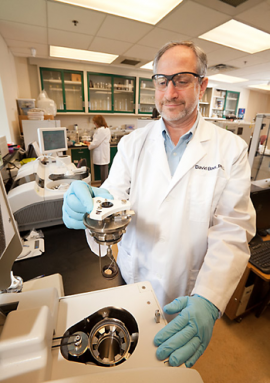
These wastes were freeze-dried and ground into a powder. Then it too was bombed in the calorimeter. “It is kind of an unusual thing to do,” Baer admits, but he’s used to it. His team has special equipment to keep the process clean and safe.
Afterward, the researchers subtracted the calories in the excreted wastes from the calories that had been in the day’s meal. This revealed how much energy the food had left in a volunteer’s body. After crunching the numbers this way, Baer’s group found that the nuts didn’t provide as many calories as food labels would have predicted. This meant the diners had not digested the nuts completely.
Whole almonds delivered 25 percent less energy than expected, walnuts 21 percent less and pistachios 5 percent less.
Why?
“Nuts are plants,” explains Baer. Each plant cell is surrounded by a thick wall that humans can’t digest. Chewing or grinding can break through those walls, allowing access to the energy inside. But that won’t break down every cell’s wall. As a result, some bits of nut end up passing through the body undigested. And with the undigested wastes go calories — right down the toilet.
Nuts are part of a healthy diet, says Baer. They provide important vitamins and minerals. But he worries that the high calorie counts on many nut labels may discourage some people from eating them. Eventually, research like his could help update the labels. “I’d like consumers to have accurate information,” he says.
Training brains off junk food
Not everyone uses the numbers on food packages to help them decide what to eat. “I do not count calories. It’s too boring and unpleasant,” says Susan Roberts. She is a nutrition scientist at Tufts University in Boston, Mass. There, she specializes in weight-loss tactics. For her, it’s personal. “I was very overweight as a young kid and then as a young adult,” she says. She learned to manage her own weight and now helps others.
Instead of focusing on calories, Roberts teaches dieters to love healthy food. She combined her knowledge of cooking (she once worked as a chef) and science to create a diet program called “Instinct Diet,” or iDiet. It provides recipes for meals that taste like unhealthy foods but contain healthier ingredients. For example, the chocolate pudding recipe involves mixing cocoa and vanilla extract into nonfat ricotta cheese.
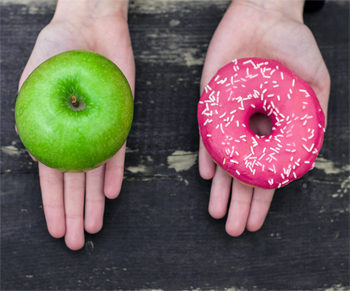
Most of Roberts’ recipes contain more protein and fiber than do common American foods. They also contain less sugar. Sugar tastes good, but the body uses up its energy quickly. Energy from protein lasts longer. It helps keep the dieter from feeling hungry an hour or two after eating.
As people make a habit of eating healthy food, their brains start to change, Roberts’ research has shown. Over time, cravings for junk food seem to shrink while the desire for healthy food grows. In one 2014 study, Roberts and her colleagues teamed up with brain researchers from Harvard Medical School in Boston, Mass. Together, they followed 13 overweight or obese volunteers for six months. As a control group, five volunteers did not eat the iDiet. The eight who did received recipes and attended classes and support groups.
At the beginning and end of the study, each volunteer climbed inside a functional magnetic resonance imaging (fMRI) machine. It measures blood flow to different areas of the brain. While inside the machine, the volunteers looked at pictures of food. Some were lower-calorie items from the diet, such as grilled chicken breast. Others were high-calorie offerings, such as fried chicken. Throughout it all, the fMRI machine recorded activity in a part of the brain that tends to turn on when it encounters something that it finds “rewarding.”
This area lit up with activity when someone looked at pictures of foods he or she found appealing.

At the beginning of the study, high-calorie foods such as fried chicken were more appealing to most of the volunteers. But after six months on the iDiet, “people’s instinctive response was totally different,” says Roberts. The reward region of iDiet-volunteers’ brains activated more in response to grilled chicken and other lower-calorie foods. Meanwhile, their reward center lit up less in response to high-calorie food.
This was a very small study. But Roberts hopes to repeat it on a larger scale. In the meantime, she’s been busy in Guinea-Bissau, a country on the west coast of Africa. There, many people can’t get enough calories. Her team is developing a nutrient-rich bar to distribute to local kids. The bar will provide vitamins, minerals, protein and calories to help them grow.
Cooking up some chemistry
Roberts uses her knowledge of nutrition to devise better recipes for foods that people can make at home. Similarly, scientists at food companies work behind the scenes to develop new recipes for products that appear on grocery shelves.
Pushparajah Thavarajah works as a food scientist at B.O.V. Solutions Inc. in Statesville, N.C. There, he uses chemistry to create healthier versions of foods. He is currently working on a gluten-free pancake mix. Gluten is a substance found in wheat and several other grains. It’s an important ingredient in many baked goods. “Gluten is gumming,” he says. It helps the pancake stick together. But some people can’t eat gluten.
Thavarajah uses his knowledge of food chemistry to scout substitutes for gluten and certain other food ingredients. The source of those substitute chemicals may be corn, rice or potatoes. Even if the new ingredient helps the pancake stick together, his job isn’t done. “You have to make sure it tastes okay,” he explains. For that, his team works with panels of taste testers. They try each new food before it ends up in grocery stores.
Thavarajah also works with students at several different universities, including the College of Chemical Sciences in Rajagiriya, Sri Lanka. He is originally from this small island nation off of the southern coast of India. His students have been using chemistry to change how the body processes carbohydrates.
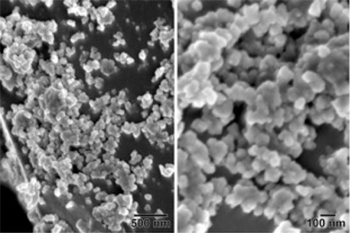
There are three basic types of carbs: sugars, starches and fibers. Sugars are sweet molecules such as sucrose (table sugar) and fructose (naturally found in fruit). The simple sugar glucose links together into chains to make starches, such as those found in rice, grains and corn. Fiber is an even longer chain of glucose. This strong molecule forms a structural part of plants.
The digestive system easily converts sugars and starches into energy, but it can’t break down fiber. (That can be a good thing for the body, though. Lots of fiber in the diet can help the digestive system keep things moving through it.) Thavarajah and his students found ways to replace regular starch with a variety called resistant starch. This carbohydrate acts like fiber since it resists digestion. But it mimics regular starch in texture and taste.
Because resistant starches make fewer calories available to the body, Thavarajah notes, they can be valuable in food products. One of his students, Paul Fenlason of North Dakota State University in Fargo, extracted resistant starch from corn. He used it to replace the flour in a birthday cake. Sudhair James, another student, invented a new cooking method for rice. That technique increases the amount of natural, resistant starch in the rice.
James is one of the students working in Sri Lanka. He started with a known technique. Cooking a starchy food and then cooling it for at least 12 hours transforms some regular starch into a resistant form. Reheating the food doesn’t change it back. Since the resistant starch doesn’t get digested, some of the energy-containing molecules in the meal pass through the body undigested.
The end result is a dish that leaves fewer of its calories in the body. This process happens in all starches, including rice, pasta and potatoes. “It’s true,” says Thavarajah. “Leftover potatoes are lower calorie than fresh!”
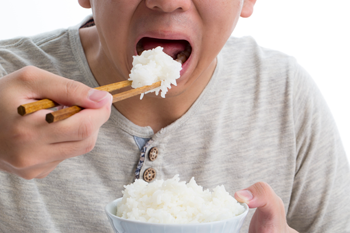
James, though, discovered that adding a small amount of coconut oil while the rice was cooking converted more of the starch to a resistant form. The fat in the oil joins with some of the starch molecules to create resistant starch. The method converts 10 to 15 percent of the starch in rice into a resistant form. This in turn reduces the available calories by a similar amount.
People need calories to fuel their bodies, but that’s not all a body requires, notes Thavarajah. The body also needs dozens of vitamins, minerals and other nutrients to thrive. Today, half of Americans aren’t getting enough of these.
The problem is that calories are too cheap and plentiful. As a food scientist, Thavarajah can produce a calorie-rich food for just a few dollars. “Adding the other 50 nutrients gets extremely expensive,” he points out. So he is looking to foods that start out nutrient-rich, such as kale and lentils, to possibly deliver more of these essential molecules at low cost.
Calories, then, are just the starting place for figuring out how to eat well. But the more people learn about nutrition, the better the chance they will make good choices at meal times.
“Food, chemistry and nutrition are very important,” says Thavarajah. “They directly affect your health.” His advice is to learn to love healthy foods. Fill up on lentils, chickpeas, peas, beans, vegetables and fruit. Your body, he says, will thank you.
This is one in a series on careers in science, technology, engineering and mathematics made possible with generous support from Arconic Foundation.







